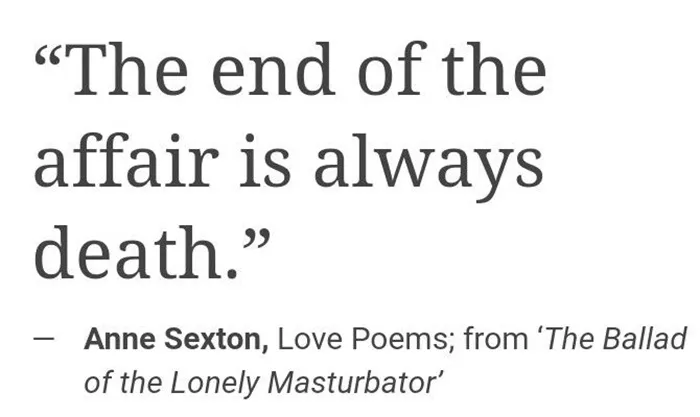Welcome to Poem of the Day – The Ballad of the Lonely Masturbator by Anne Sexton
Anne Sexton, known for her raw and confessional style, offers a striking and provocative piece in her poem “The Ballad of the Lonely Masturbator.” Written during the 1960s, this poem delves into themes of isolation, desire, and self-reflection. It presents a stark and unapologetic view of human sexuality, loneliness, and the complexities of self-love. In this article, we will break down the poem’s meaning, themes, and techniques to better understand the depth behind Sexton’s powerful writing.
The Ballad of the Lonely Masturbator Explanation
Overview of the Poem
The poem portrays a deeply personal and intimate narrative in which the speaker reflects on the act of masturbation. This is not just a physical act; it is symbolic of deeper emotional and psychological struggles. Sexton crafts a ballad, a form traditionally used for storytelling, to highlight the speaker’s isolation and yearning for connection. Through vivid and, at times, explicit imagery, the poem explores the feelings of loneliness and the search for meaning in a solitary act.
Tone and Mood
The tone of the poem is candid, dark, and reflective. Sexton does not shy away from using blunt language to explore taboo subjects, which contributes to the rawness of the piece. The speaker’s isolation is palpable, and the mood reflects a sense of melancholy and frustration. It’s clear that the act of masturbation is more than just a physical release; it becomes an expression of emotional emptiness and longing.
Themes of Loneliness and Desire
One of the central themes of the poem is loneliness. The title itself, “The Ballad of the Lonely Masturbator,” suggests that the speaker is caught in a cycle of self-reliance, yet finds no true fulfillment. This isolation is not just social, but emotional. Sexton uses masturbation as a metaphor for the speaker’s search for intimacy, which remains unfulfilled. The speaker’s physical act is an attempt to connect with something or someone but ultimately leaves them feeling empty and alone.
Desire, both physical and emotional, is another prominent theme. While the poem explores the body’s longing for sexual release, it also underscores the deeper desire for connection and love. The act of masturbation in the poem symbolizes a desperate attempt to satisfy an innate human need for affection and companionship, but it falls short, highlighting the complexity of human desires.
Symbolism and Imagery
Sexton’s imagery is vivid and explicit, creating powerful symbolism. The body, in this poem, becomes a battleground where the speaker struggles with desires they cannot fully express or satisfy. The act of masturbation is shown as both a release and a cycle, perpetuating the speaker’s loneliness rather than resolving it. Sexton’s choice of imagery invites the reader to reflect on the physical act and its deeper emotional and psychological implications.
The repetition of physical imagery throughout the poem serves to emphasize the continuous nature of the speaker’s isolation. The act is not one of relief but of a loop that traps the individual in a cycle of unfulfilled desire. In this sense, Sexton uses the physical as a gateway into understanding more profound emotional states.
Structure and Form
“The Ballad of the Lonely Masturbator” follows the traditional ballad form, which often focuses on personal stories or tales of individuals, frequently involving themes of love, loss, and death. The ballad form works well in this poem because it gives the speaker’s story a sense of rhythm and cadence, pulling the reader into the narrative. The repetition of the ballad structure mimics the cyclical nature of the speaker’s loneliness and desire, reinforcing the theme of endless yearning.
The language is direct and unapologetic, with Sexton employing a confessional style that is characteristic of much of her work. This style allows the poem to convey raw emotion and vulnerability, making it resonate with readers on a personal level.
Conclusion
In “The Ballad of the Lonely Masturbator,” Anne Sexton presents a profound exploration of isolation, desire, and self-love. The poem’s candid tone, vivid imagery, and use of the ballad form make it an impactful piece that challenges societal taboos surrounding sexuality and loneliness. By focusing on a solitary act, Sexton delves into the complexity of human emotion and the struggles of seeking connection in a disconnected world. The poem is not only an exploration of a personal experience but a reflection of the universal human need for love, intimacy, and fulfillment.
Anne Sexton’s work continues to inspire and provoke readers, and “The Ballad of the Lonely Masturbator” remains a powerful example of her ability to use poetry to explore the darker and more intimate corners of human existence. Through her bold and honest portrayal of the speaker’s inner world, Sexton gives voice to the silent struggles many face, reminding us of the complexities of desire and the loneliness that often accompanies it.

